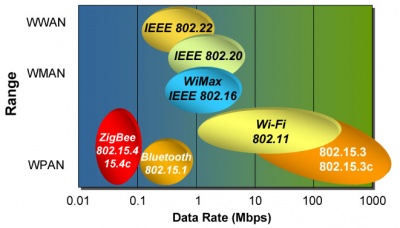ZigBee
From Computing and Software Wiki
ZigBee, is a wireless open standard and a competing protocol to Bluetooth, which fall under wireless personal area network (WPAN) classification. It is a standard for mesh networking, with allows for self configuring networks, ease of installation and configuration. It is designed for low power applications, especially applications that are designed for very long batter life. It has a low data rate of 20-250Kbps, depending on the band. The protocol is designed with security in mind.
ZigBee is defined and promoted by the ZigBee Alliance, a group of over 150 companies. The current push is for industrial plants where low cost and long battery life remote sensors are required for process control and preventative machine maintenance.
Contents |
Uses
It is intended to be used for home entertainment and monitoring sensors, mobile services such as m-payment and m-healthcare, commercial building monitoring such as HVAC and access control.
The current application is for low power, low data rate wireless sensor networks (WSN).
Technical Information
ZigBee is based on radio frequency (RF) technology and mesh networking. It is a suite of protocols that covers from the Physical layer, Network layer to the Application layer. The physical layer is an implementation of IEEE 802.15.4 (Bluetooth is covered under IEEE 802.15.1).
Standards
Interoperability
Zigbee is designed to operate near other devices. ZigBee falls within the 802 family of standards, which includes Wi-Fi and Bluetooth.
There has been some speculation that use of 2.4Ghz bandwidth introduces significant interferance. Such claims have been refuted by a paper released by ZigBee alliance.[6]
ZigBee Alliance
Market
With the WSN market grow to estimated $4.6 billion in 2011, up from $500 million in 2007; ZigBee is a strong contender to become the standard for WSN. Companies can adopt this protocol into its products in an attempt to gain the market share. Also, industrials plants can gain the benefits from better monitoring and control of process, thanks to the lost cost and easy of deployment of wireless sensor networks based on ZigBee.
See also
References
- ZigBee Overview. Retrieved on April 5, 2008 from <[1]>
- An Overview of ZigBee - The Power of the Mesh. Retrieved on April 5, 2008 from <[2]>
- Home networking with Zigbee. Retrieved on April 3, 2008 from <[3]>
- Choosing wisely for embedded ZigBee apps. Retrieved on April 3, 2008 from <[4]>
- ZigBee specification. Retrieved on April 3, 2008 from <[5]>
External links
- Test


